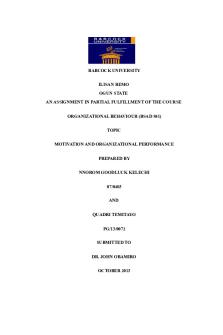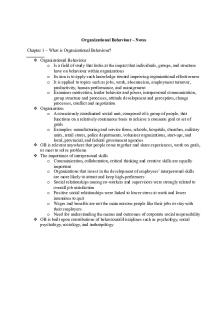Personnel Management And Organizational Behaviour - Jay Aneja PDF

| Title | Personnel Management And Organizational Behaviour - Jay Aneja |
|---|---|
| Author | Ajay Aneja |
| Course | Ecommerce |
| Institution | Escuela de Negocios Europea de Barcelona |
| Pages | 23 |
| File Size | 597 KB |
| File Type | |
| Total Downloads | 90 |
| Total Views | 263 |
Summary
FINAL PROJECTFinal Project GuidelinesPlease use this format to submit your final work. The paper must follow all the guidelines as instructed in order to obtain full credit.Remember that our team of tutors is available for any questions regarding your final work. You must present the final version o...
Description
FINAL PROJECT
Final Project Guidelines Please use this format to submit your final work. The paper must follow all the guidelines as instructed in order to obtain full credit. Remember that our team of tutors is available for any questions regarding your final work. You must present the final version of your work as no previous corrections will be carried out. To submit the final project, students must use the template below, with their answers written after each statement. Please present your final paper according to these requirements: ● Arial 12 Font. ● Margin: 2,5. ● Line spacing: 1,5. ● All fields on the cover page must be completed. ● The document needs to be properly paged.
Your final project must be authentic and individual. Any work that has been plagiarized or papers written by others or with the help of others are likely to be failed. If this occurs for the second time, you will not be permitted to obtain your degree. Be aware that you are permitted a maximum of two submissions per subject. If both projects do not meet the standards and fail, the student must pay the corresponding fee to be evaluated again. When writing your final project please use Microsoft Office, Adobe or Apache's Open Office Writer tools (DOC, DOCX, ODT, PDF, etc.). Please consult your tutor when using a different format. Additional information about the software will be needed.
1
Please use the following format: ddmmyyyy_Subject_LastNameandName.pdf Example: 11052019_StrategicManagement_ElsaMoore.pdf The project should not exceed more than 18 pages, excluding the cover page, bibliography and the appendix.
Evaluation Guidelines
The final work will be evaluated based on the following criteria: ● Acquired knowledge (25%): the knowledge acquired throughout the course of the subject will be evaluated through the analysis of the theoretical data shown in the project presented by the student. ● Development of the Subject (25 %): the interpretation of the thesis subject by the student and its development will be evaluated in a coherent and analytical manner. ● Final result (25%): the final evaluation is based on coherent solutions applied to solve objectives set out in the paper. The presentation
must
be
conclusive
and formatting must meet
established parameters. ● Additional
information
and
bibliography
(25%):
additional
information regarding the research and subject matter will be evaluated and taken into consideration as a bonus. This consists of: bibliography, visual graphics, charts, independent studies carried out by the student, external academic sources, articles of opinion, etc. All
2
sources, both printed and online, must be referenced according to the APA regulations.
BACKGROUND The company Art's Food is an organisation with 28 years of history in the area of services. The company's headquarters are located in Sabadell, although the services are provided in numerous points of the Catalan territory. The company has three areas (Educational, Hotel and Events), all related to catering. The company achieves a higher turnover in the educational area, dedicated mainly to serving the catering of a large number of schools (currently more than 150). This area is a great entrance of money for the company, but it also requires a great structure and organisation. The feeling of the worker is that the future and the viability of the company mainly goes through the proper functioning of this area. However, although in recent months the department has been meeting the objectives set and continues to gain public and private tenders (which means more schools and clients), there is widespread discontent among its workers, since the management is not knowing how to handle the situation and that translates into a poor environment.
Raquel Torrà is the director of the educational area, a competent and proactive woman, with more than 10 years in the position. Above her there are only Josep Font, Chief of Operations, and Roger Art, founder and director of the company. They have a way of understanding the business world that is very classic and authoritarian, they do not take their workers into account, and they only move by objectives. In turn, they derive full responsibility from the area directors to communicate the decisions to their workers. They do not usually have direct contact with the workers and, if they do, it is scorched and hostile
3
Roger is only interested in obtaining good economic results without caring about the personal situation of his workers. An example of this is that, on average, workers in the educational area are having to do 10 extra hours a month to be able to fulfil their tasks. This situation is common in recent months and, far from solving it, their opinion is "they’re supposed to work, that’s what we pay them for". He has also been heard saying, on more than one occasion, phrases such as "if they are not motivated it’s not my problem, they should come motivated from home" or "they should manage with the resources they have" when asked about strengthening the educational area team. All this situation is generating negative repercussions for the future of the company in general, and in the educational area, in particular, although management doesn’t seem not to notice. The educational area is made up of 19 workers. As has already been mentioned, Raquel is the director of the area and has a very experienced and prepared team, both in the operational and commercial sectors. In turn, she is characterised by having excellent communication skills and a very remarkable ability to lead, which is helping to relieve the bad environment somewhat, but she doesn't know how long she will endure. Her team consists of 12 area coordinators who mainly perform the work at a distance during their working day, as they are responsible, in an autonomous manner, to supervise the proper functioning of the service of the schools in each area. The remaining 6 workers are two commercial employees, who are responsible for preparing and managing the active competitions; a personal assistant of Raquel, who offers direct support to her and to the area coordinators; an administrative assistant, responsible for customer service and various tasks; an office clerk responsible for managing routine actions; and a product technician, in charge of negotiating prices and managing incidents with suppliers. In general, there is a good atmosphere among all of them, although the continuous stress and the lack of empathy from the direction are beginning to generate problems.
4
The members of the educational area that are in office are as follows:
-
Joan: salesman. He has been with the company for six years and is a severe and responsible person. For him, the most important thing is to do his job well above everything and everyone. He does not have a bad relationship with his peers, but he is selfish. He considers himself well positioned and happy with his situation as he receives bonuses for won tender.
-
Enrique: salesman. This is his third year in the company and, unlike Joan, he gets along very well with the other colleagues in the area. He is a
very
happy
and confident person, highlighting his excellent
communicative ability. For him, the current situation is neither fair nor sustainable. -
Lorena: She has been in her position for three years (assistant to Raquel) and is a crucial player in the group. She is a very cheerful person and is confident and confident in her work and training. She is the wild card of them all because her position in the Educational area makes it indispensable for the proper functioning of this area. She is dynamic and always takes the initiative and is willing to help anyone who needs it. However, despite her importance in the company, she does not feel valued by management.
-
Elisabeth: The most senior employee, she is tasked with managing routine actions. In spite of not having any type of training, she strives to do her job well and has a great ability to be heard and avoid friction with customers. She is a smiling person and always tries to improve the day for her companions.
-
Julia: she has only been with the company for 5 months. She is an administrative assistant and deals with customer service (parents), among other administrative tasks. Being the youngest of the group, she does not want to enter into controversies and tries to go unnoticed. She is unsafe on many occasions, as she notices that the work environment is rarefied.
5
-
Anabel: has been working on the product for more than 8 years. Her significant experience makes her a specialist in her field. It is well liked by her peers
Although the area coordinators do not usually work in offices, they have their common work area in them. They are a cohesive group, but the stress and lack of recognition by management are beginning to generate conflicts, resulting in a decline in service quality. In general, most coordinators are open to helping colleagues, which facilitates their work and the resolution of possible arising conflicts. Finally, Raquel's personal assistant has informed the company of her decision to accept a work offer, since she considers that she has not been sufficiently valued (when she was admitted, she was offered a salary below what was said in the interview, and they haven’t reviewed it since she’s been in the company). The situation stresses them a lot, since she gets along great with Raquel and with Anabel, Julia, Enrique and Elisabeth, and they form a very competent and cohesive working group, helping each other in everything they need. They have the same opinion about Roger's management, and they are considering taking similar measures if the situation does not change.
DEVELOP 1. Analyse the current Art's Food situation in terms of human capital. Then, from an analytical perspective, answer the following questions: a. What is the position in which the staff of the Educational Area have found themselves? The workers of Art’s food that work in the educational area are: ● Not motivated ● Not appreciated by management ● employee morale is low
6
● Discontent ● Underpaid ● Lack of Job satisfaction ● Endure long hours and work overtime ● Employees are on the verge of leaving their jobs. b. Define the causes of how this point has been reached and what consequences can be derived if you do not intervene.
CAUSE
IMPORTANCE
EFFECT
Roger Art does not take his workers into account when making decisions
Lack of empathy and lack of self determination for the workers is making the work environment very toxic
When workers are not appreciated, they tend to be very unhappy and this leads to higher turnover rate among workers
Workers asked to work extra hours
work-life balance is disrupted
Leads to low morale of the employees
Workers shunned by management
Workers want to be appreciated
The worker’s attitude could turn 180 degrees and they might not cooperate with management
Managers direct communication with workers is scorched and hostile
Hostility from management will lead to hostility in response by workers
Worker’s behaviour could turn hostile towards management. A classic tit for tat situation.
Selfish behaviour ( Individualism )
Selfish behaviour rewarded which would lead to disintegration of team work.
Will lead to bickering and fighting at work as all workers will look after their self interest before company’s or co-workers
Worker’s welfare is not being considered by management
Employees feel neglected
Stress level at work increases, leading to chronic sickness, hence more time is taken off by employees
Lack of partnership between Management and employees is highly apparent
Humans are social animals and have an innate sense of belonging to a group
Young poet Mattie Stepanek once said, “Unity is strength... when there is teamwork and collaboration,
7
wonderful things can be 1 achieved.”
c. Draw up the needs that you think the company requires and which Management hasn’t detected. Management of Art’s Foods is to blame for all the troubles faced by the employees as management’s goal or rather, Roger Art’s goal is to “obtain good 2 economic results without caring about the personal situation of his worker’s”
Roger Art is an authoritarian leader, and by an authoritarian leader we mean that one person or a small group of individuals who have full control over the decisions of an organization with little or no input from group members. Autocratic leaders make choices based upon their ideas, judgement and goals without any consultation or input from group members. The leader in this case has full and absolute control over a group. An authoritarian leader is useful in some situations, such as in the Army at times of war but this approach has negative consequences when applied to the operation of a Corporation in the present times. Below are some items that management of Art’s Food has not considered or detected, that can and will have an impact on the operation of the education department: ● Art’s food does not recognize their employee’s hard work ● Workers are asked to work 10 hours overtime a month. This equates to 120 hours of overtime a year, which is illegal, due to Spanish labour laws that state that no more than 80 hours a year of overtime can be undertaken by an employee ● Salary and benefits are below par when compared with other organizations and some employees have not received a pay raise since they joined Art’s Foods ● There is no concept of teamwork within Art’s Food
1 2
https://msutoday.msu.edu/news/2014/unity-is-strength/ ENEB Final Assignment for Personnel Management and Organizational Behaviour
8
● Every man/woman looks after their own interests, agenda and benefits. Art’s Foods has to stress that workers work hand in hand towards a common goal ● Workers job satisfaction is of no importance to the management, therefore morale in the organization is quite low ● Workers not only are motivated with a salary but they require that there is recognition for their hard work ● Employees need a challenging work environment where they may utilize their work and educational experience to the fullest extend ● Outside of work socialization and get-together foster a sense of comradery in employees and can lead to a more productive labour force 2. Once the situation is analysed: a. Define the stages of evolution in work teams and identify in which stage the Educational Area of the company currently is. There are four stages in the formulation of a team and the evolution happens over these stages as employees become part of a team 1. Formative Stage: This is when the team is brought together and every individual gets to know what their position or hierarchy is in the organization. In this stage, individuals should set personal goals and realize how their personal goals amalgamate with the organizational goals. This stage ends when newcomers are welcomed into the team or group 2. Conflict or Storm Stage: In this stage, emotions come out and internal conflicts arise due to the personality of the individuals who make up the team as everyone is trying to outsmart the other team members or trying to gain some advantage over his fellow coworkers. Workers divide themselves into sub-groups and take opposing sides based upon their beliefs and which group offers them more advantageous terms and benefits. This stage is very crucial to team building as it can either make a team or break it. This stage ends when the leaders are chosen among the team members and a clear hierarchy is established among the group
9
based upon their personality, knowledge, position in the organization and leadership skills. 3. Normalization Stage: In this stage team members start to work as a cohesive unit and start to operate towards a common goal or mission. The team in this stage will establish social connections among its members to strengthen the team as a whole. This stage ends when the individuals become a team and function as a well-oiled machine: which works without a lot of friction among the team members and the cohesive unit is fully functional and operational. 4. Performance Stage: This is the stage where all the tasks and goals are achieved. In this stage, there is complete integration among team members and the team achieves its final goal. In this stage members of the management can delegate some of their responsibilities to their 3 subordinates and concentrate on other areas that need oversight.
The educational Area is at the Storm or conflict stage as everyone is fighting and back-stabbing their fellow workers. b. Identify the formal and informal teams that you detect in the company and justify your response. A formal team is said to be a team that is created by the organization to carry out or implement certain tasks or specific goals that are desired by the entity. These teams are sanctioned by the organization. These teams generally are temporary and are disbanded upon completion of the desired task or achievement of a particular goal. Committees can also be formal teams such as the Student committee in University. This type of team deals with recurring decisions and problems that students face while at University. These types of teams are formed to stay in place for a long time, while students and committee members may join and leave upon graduation, the committee team is perpetual and continues to function with new members and new students, replacing the departing team members. 3
https://www.mindtools.com/pages/article/newLDR_86.htm#:~:text=Psychologist%20Bruce%20T uckman%20described%20how,move%20them%20through%20the%20stages.
10
On the other hand, informal teams are not sanctioned by the organization but these teams come together because of the interaction of certain people in the organization. The team members work towards a common goal and achieve results as there is strength in numbers.“Functions of informal Groups:
Informal groups serve four major functions. First, they maintain and strengthen the norms (expected behaviour) and values their members hold in common. Second, they give members feelings of social satisfaction, status and security. In large corporations, where many people feel that their employers hardly know them, informal groups enable employees to share jokes and complaints, eat together and socialize after work. Informal groups thus satisfy the human needs for friendship, support and security.”4 There are three main areas of the hospitality industry that Art’s Foods deals in Educational, hotels and events. Under the Educational team, 19 workers are subordinate to Raquel. She as director of the area has managed to form a cohesive group because of her excellent communication skills and her astonishing ability to lead her team. This is a formal team that has been structured by the organization. The Informal team within Art’s Foods consists of the following employees in the Educational area: Raquel, Lorena, Anabel, Julia, Enrique and Elizabeth. All the team members help each other in times of need, especially as they all are faced with a very poor work environment and employee morale is quite low.
c. Following the typology of Meredith Belbin, give a role to each of the workers in the educational area who are in the...
Similar Free PDFs

04042021 e-commerce Aneja JAY
- 16 Pages
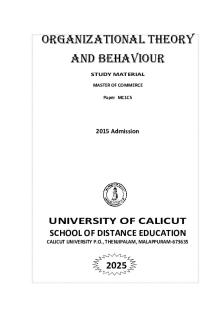
Organizational theory and behaviour
- 186 Pages
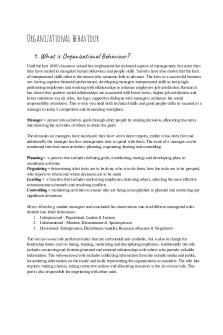
Organizational behaviour
- 67 Pages

Organizational Behaviour
- 2 Pages
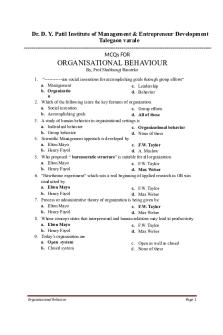
Organizational Behaviour mcqs
- 27 Pages
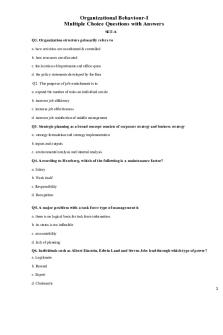
Organizational Behaviour MCQ SET
- 20 Pages
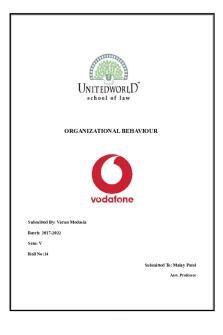
Organizational Behaviour Project
- 15 Pages

Chapter 2 ORGANIZATIONAL BEHAVIOUR
- 23 Pages

Organizational Behaviour Glossary
- 17 Pages
Popular Institutions
- Tinajero National High School - Annex
- Politeknik Caltex Riau
- Yokohama City University
- SGT University
- University of Al-Qadisiyah
- Divine Word College of Vigan
- Techniek College Rotterdam
- Universidade de Santiago
- Universiti Teknologi MARA Cawangan Johor Kampus Pasir Gudang
- Poltekkes Kemenkes Yogyakarta
- Baguio City National High School
- Colegio san marcos
- preparatoria uno
- Centro de Bachillerato Tecnológico Industrial y de Servicios No. 107
- Dalian Maritime University
- Quang Trung Secondary School
- Colegio Tecnológico en Informática
- Corporación Regional de Educación Superior
- Grupo CEDVA
- Dar Al Uloom University
- Centro de Estudios Preuniversitarios de la Universidad Nacional de Ingeniería
- 上智大学
- Aakash International School, Nuna Majara
- San Felipe Neri Catholic School
- Kang Chiao International School - New Taipei City
- Misamis Occidental National High School
- Institución Educativa Escuela Normal Juan Ladrilleros
- Kolehiyo ng Pantukan
- Batanes State College
- Instituto Continental
- Sekolah Menengah Kejuruan Kesehatan Kaltara (Tarakan)
- Colegio de La Inmaculada Concepcion - Cebu

